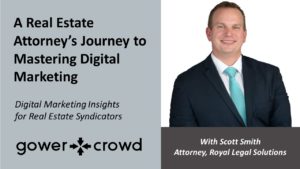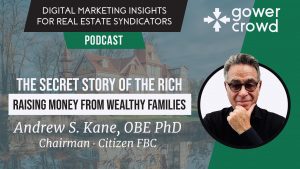FREE TRAINING
What is Real Estate Crowdfunding?
Learn how to build wealth and earn passive income in real estate while someone else does all the work.
Crisis Communications
A Guide for Commercial Real Estate Professionals
Willy Walker Chairman/CEO, Walker & Dunlop
Covid-19: The State of Finance in Commercial Real Estate
 Today's Guest Willy Walker
Today's Guest Willy Walker
In today's special Life in the Day of Coronavirus episode, you're going to hear from Willy Walker, Chairman and CEO of Walker & Dunlop. We discuss how the commercial real estate capital markets are reacting to the COVID-19 crisis.
You're going to hear about where the capital markets are today, both from debt and equity perspectives, by product type. Specifically, you’ll get insights into: Hospitality, Retail, Office, Industrial and Multi-Family defaults. We also discuss today's situation comparing it with the global financial crisis of 2008-2009. This is one of the most insightful dives into the current state of affairs across all aspects of the commercial real estate industry and a must listen/watch episode so you can stay on top of events as they happen.
What You're Going to Learn
- The Current State of Capital in CRE
- How Different CRE Asset Classes Are Impacted by the COVID-19 Crisis
- Who’s Paying Rent (and who’s not) During COVID-19
- How Forbearance and Foreclosure Play Out in a Pandemic Vs. Financial Crisis
- How Private Sector Loans and Federally Insured Loans Will Be Handled Differently During COVID-19
- The Difficulty for CMBS Loans During a Crisis
- Catch a Falling Sword – Predicting the Duration of the Coronavirus Crisis
- How Vaccine Development and Daily Car Use Can Be Indicators of Financial Recovery
- Willy Walker’s Questions, Advice and Encouragement for CRE Professionals During the COVID-19 Crisis
- And much more!
Listen To or Watch the Full Podcast Here
Show Highlights
The Current State of Finance in Commercial Real Estate
ADAM GOWER: Where is capital in the commercial real estate world today? Let's start at the very top and then we can start diving down.
WILLY WALKER: So I'd say, Adam, that capital right now is on hold in the commercial real estate space, generally speaking. It's almost impossible to determine value in the market today. And as a result of there being really no ability to determine value, mergers and acquisitions or sales activity is basically non-existent across all commercial real estate asset classes. And so, until you have the ability to assess what the value of a property is, there will be very, very limited amount of transaction volume. So the equity capital that is typically very prevalent in the commercial real estate spaces, for most part, is on the sidelines. And then, as far as debt capital is concerned, most debt capital is on the sidelines. That would include most major banks, life insurance companies and Wall Street in the form of commercial mortgage-backed securities. They are doing deals but they are very particular in what types of deals they are doing and what the financing structure of those deals are. And then Fannie Mae, Freddie Mac and HUD all supply capital to the multifamily industry and the three of them are still providing capital and are still doing quite a robust amount of lending right now.
Who’s Paying Rent (and who’s not) During COVID-19
ADAM GOWER: So, if you were to describe these as being kind of red, orange and green, right? That hotel hospitality is in the red zone and multifamily is in the green zone. How long does it take before that all starts to look orange and red, do you suppose? Because we've only had one 1st of the month so far, right? When rents became due. So that was April 1 and then we have May 1, which will take us to, what? 60-days past due. And then June will give us 90-days and at 90-days, you start to get into non-curable loan scenarios. Right, Willy? And it makes it harder for lenders to forgive and they become non-performing loans on books, etc. So it becomes much more complicated, doesn't it, the longer this lasts?
WILLY WALKER: So, I guess there there are two sides to that. One is that, if you remain focused on hospitality and retail. Those loans are either in forbearance or they're going into foreclosure. So there will be, that pain is already there to your point about using "red". Office, they're longer term leases, typically, you know, 7, 10 year leases. And so as a result of it, office properties should continue to perform perfectly fine. It's the question of renewals. It's the question of, does a WeWork stop paying rent, as they've announced that they're going to on many of the properties that they are tenants in. And what does that do to overall rent rolls and do you start to see defaults in the office space? As it relates to industrial, the real question is, how long does it, does the crisis last for and how many of those industrial centers are providing logistical services for an Amazon, who is still operating to a great degree? Or is it the nail salon that doesn't need any more of its, you know, shiny nail polish? And so, somebody who has a distribution facility for nail enamel, they're still sitting on all their product. They're not getting new products from China and that's not moving through so the distributor isn't making any money. The distributor has financial pain. That then goes to them not paying their lease.
And then all of sudden, now the owner of the industrial has a real problem. So, I don't know, who knows how long that lasts for and where the pain points are. Clearly, those industrial centers that have more of a credit tenant base to them will do better right now because those larger distribution companies are, right now, faring better than the smaller ones. On the multi-side of things, the rent rolls for the month of April have been surprisingly strong. If you look at our portfolio, which is extensive, we had expected that there would be some falloff on collections and there's been almost none. And, that is actually before all of the payments that are coming out of the CARES Act have gotten to people's bank accounts. The individual checks that the federal government put in the CARES Act have not arrived. If you had direct deposit, it arrived last Friday. But nobody who paid their April rent between the 1st and the 10th of April had that money in their bank account. Nobody who's filed for unemployment insurance has gotten a single check that has the $600 per week additional payment from the CARES Act. So, the CARES Act only lasts through July. So, to your point, as it relates to, well when does the money start flowing? It has only started flowing now.
If you look at how much of a boost the CARES Act gives to people filing for unemployment insurance, the average state in America pays roughly $350 to $360 a week, for unemployment insurance. But the CARES Act adds a full $600 to each one of those checks. So, depending on the state you're in, generally speaking today, people are making, or taking home $960 to $970 a week. So that adds up to just under $4000 a month, under the CARES Act, that people are receiving for being unemployed right now. That total is actually more than the average American worker made in Q4 of 2019 with 3.6% unemployment in the United States of America, an exceedingly tight labor market. So the real question there becomes, if people are getting this income from the federal government, which millions and millions of people have filed for. They have the very real opportunity and capability to pay their rent, at a rate that's actually below 30% of take-home pay, which is the threshold that everyone talks about, sort of, affordable rent and unaffordable rent. The question really comes into, do they continue to pay their rent or do they start to hoard cash because they don't know how long the CARES Act is going to last for
And are they afraid about some other expense, such as food or pharmaceuticals, that they want to hold onto money for? But, as it relates to the money getting into the system, it wasn't there in April. It is coming in right now, April into May, and the April collections were much better than anticipated. So, we shall clearly see, come May and June. But for right now, from a multifamily standpoint, the great majority of people, 98% of people, could pay their rent. The question is, the lower quality assets, "the C's" and whether those income tiers are going to pay rent. And that has been the one place where we have seen some lag in rent rolls, of people not paying their rent on time. Not nearly to the degree we thought, but there is more in that, sort of, lower rung. And again, going back to the point I made as it relates to unemployment insurance. Anybody in that lower rung, who has filed for unemployment benefits, hasn't gotten that step up. So there's actually a viewpoint here, on those lower, sort of, C-Class assets, that you actually might get better collections in May once they've started to get these dollars from the federal government, then you got an April where the dollars hadn't started flowing and they'd lost their job.
FOR REAL ESTATE DEVELOPERS
THE WHITE BOARD WORKSHOP
Learn the exact system best of class sponsors use to raise money online.
How Forbearance and Foreclosure Play Out in a Pandemic Vs. Financial Crisis
ADAM GOWER: You know, I went through the 2008 downturn. Actually, I was brought into a bank to help them clean out their balance sheet. I was lucky enough to have sold my portfolio in '07. So it's definitely different this time. But how does the foreclosure process work this time, meaning, in the sense that, the decisions that banks make? If this is something that is beyond the normal run of events, why even are banks considering foreclosures? Is it because they're mandated to, once loans go into a certain level of default or is it because that the borrowers are fundamentally unsound or, you know, are not on a solid foundation in terms of the way they structured their capital stack in the beginning? In other words, is this just going to wash out weaker borrowers? What exactly is going on with with banks and the way they look at foreclosing at the moment?
WILLY WALKER: Well, A- it's too early to, sort of, make broad generalizations. Every financial services institution is making their own decisions as it relates to allowing for forbearance or foreclosing on a loan that's in default. I would put forth, I've heard all sorts of distinct reactions as it relates to people asking for forbearance from: the next 3 months are on us, just put your head down, be ready to go when this thing clears up, and we're with you, to, no, we're not going to give any leniency, no forbearance. If you want to default on your loan, you default on your loan. So, it runs the full gamut. I would say, that you have to keep in mind, that this crisis is very distinct from the great financial crisis. In the great financial crisis, the banks were running scared, from the very outset. It was a banking crisis. It was a liquidity crisis. We are not seeing any of that today. So the banks are exceedingly well-capitalized. They have plenty of liquidity. The Fed has flooded the market with liquidity. The SBA loan program that started a week ago, Friday. They say it's going to be depleted by this coming Friday. That's three hundred and fifty billion dollars that the federal government has put into small businesses, across the country, to allow them to keep their payrolls going.
And 75% of those loans can be used for payroll, and that 75% is all forgiven, if you use it for human resource costs during this downturn. So, the immediate reaction in 2008 was a complete freezing of liquidity. People pulled in warehouse lines, people called every repo line they had. And if you went to a bank and asked them for any kind of leniency, it was essentially, here's the hand, give me my money or you're in default. That is 180 degrees away from where we are today. Maybe I should say it's 170 degrees because there are some people who are saying, I need your money, I'm calling your line, I'm calling your loan, don't talk to me. But it's a very different approach today. I think the big question is, this week is when people are starting to really think about, OK, we were in, kind of, freefall for 3 weeks. The virus was hitting. It was growing dramatically. We were all scared for our lives. We were scared for our loved ones and it was a real crisis of companies adapting to the new norm of either shutting down, or like Walker & Dunlops, sending everyone home and saying, we've got to keep working, but we can do it in a remote basis.
Then all of sudden, last week, when you started seeing that we seemed to be flattening the curve and getting to peak demand for medical services in New York City. Everyone said, huh, well, maybe this isn't going to go as deep as we thought. Maybe we're all not going to die. And let's start to think about the potential upside. And so you had this great, kind of, euphoria of, the storm isn't going to be quite as bad as everyone expected and we actually can start to think that, it's going to pass. And so the market's inflated up again. Now, the question is, sort of, what do we do next? How long does it take for us to get out of this? How long is it going to take for the economy to get back up and get going? And until that question is answered, everyone who has a commercial real estate asset doesn't really know how deep the crisis is going to be and when they're going to start to get back to, if you're a retail mall owner, when are people going to come back to your mall? Can you project that 50% of your activities are going to be back in September? I don't know. Can you project 75% in September? Probably not. 25% in September?
That's a totally different calculus. If you're in the hospitality space and you own some big hotel in a major urban center. How many of your conferences have been canceled? How much travel do you think that someone like, I mean, I spend 200 days a year on the road. When do you think Willy Walker is going to start traveling again? I don't know. I can almost guarantee you, I'm not going to be getting on an airplane in May. Maybe something will require me to get on a plane in May. But even if they call "all clear". Why am I going to get on a plane? And if I do get on a plane, I'm probably going to fly out, do something and come right back home. Well, why am I going to go stay at a hotel for the night? Right? So I think one of the big questions here is, what's your projection of how long this lasts for? And then, if you're the owner, how long do you keep feeding the asset? And if you're the lender, how long do you work, as it relates to a forbearance period, before you sort of say, okay, start paying. How much pain do you then pass onto the owner and when does one finally capitulate and say, I'm out.
How Private Sector Loans and Federally Insured Loans Will Be Handled Differently During COVID-19
WILLY WALKER: Let's differentiate between the private sector and then federally-insured loans, because there are two sides to that. One is, if you have a loan from a life insurance company or from a bank, they can do whatever they want. They can either foreclose on you and hold a hard line or they can sit there and try and work with you. I think that's all borrower- specific. It depends on your balance sheet. It depends on their overall exposure to you. I think it depends on the asset class and whether the future looks either, you know, wipe-out bleak or just a little muddy right now and we'll wait for a little bit longer to see what it looks like. Whether this, I mean nobody right now is calling for a V-shaped recovery. Is it a U-shaped recovery or is it a Nike swoosh? If it's U-shaped recovery, people might hang on a little bit longer. If it's a Nike Swoosh, not so much. Right? So I mean, that's all going to come forth in the summertime as we start to see how this thing gets back up and going and how quickly people are put back to work. As it relates to federally guaranteed,
There's a, Fannie and Freddie and HUD all have forbearance programs in place right now, mandated by the federal government on both single family as well as their multifamily lending. So for a 90-day period, if you want forbearance, you get it. So there's no, their decision points there, to companies like Walker & Dunlop about whether we're going to grant forbearance. But Fannie and Freddie and HUD all have forbearance plans in place, which allows the borrower to ask for forbearance for 90-days. And then on the other side of that, they start to pay back the payments that they were due to pay for the 3 months, over a 12 month period. And so, that's there. People can access it, if they need to access it. And as I said previously, so far, the number of people who have accessed that is very, very low because the rent rules have held up much better than people had expected.
The Difficulty for CMBS Loans During a Crisis
WILLY WALKER: The final one is CMBS and CMBS is the least, sort of, personalized borrower-lender relationship there is. So you go to a life insurance company. Chances are the life insurance company knows you. They know your asset. There's somebody there if you pick up the phone and call them, say, hey, my name's John Smith. I've got a loan that's in trouble. Can we work on this? Same with banks, right? They know the assets that they've got loans on. CMBS, sorry, there isn't that person at the other end of the phone. Your loan has been originated typically by a mortgage broker, who has taken the loan to a Wall Street firm that is underwritten the credit has put it into a pool of loans. That pool of loans is then sold off to investors. Those investors are pension funds and institutional investors around the globe. They own one little piece in a bond of a much, much bigger pool of mortgages. And if your loan has got problems, you can't even get any relief from, you can't talk to anybody today until you actually default on the loan because your loan is called the master servicer who sits there and takes all the payments that the borrower makes and they come through to the master servicer and then the master servicer takes all those bond payments and sends it out to the bondholders. So if you've got a loan with a problem to it, that master servicer isn't the person who's going to work that out. The loan has to move from master servicing to something called special servicing. And then once it's moved from master to special, you can then go talk to the special servicer about a forbearance program, about a workout, about what to do with the deal.
But until it moves from master to special, you're literally talking to a call center employee who has no vested interest in your loan or in you. And so, there are some CMBS loans where if you feel that there is imminent default, you can call up the master and say I'm just about to go into default, can you please move it for me over to special? But in many loan docs, you can't even get that done. You can't say I'm in imminent, you know, I'm just about to default, can you move it over to special?You've got to wait until you actually don't pay. And then it moves from master to special and then you can talk to the special servicer. So all of that is very, I mean, that was the same thing that happened in the great financial crisis. CMBS got absolutely smashed in the great financial crisis. And the issue back then, was a much more significant percentage of CMBS pools were multi-family properties back then, which actually fared pretty well through the great financial crisis. This time, there's significantly less multi-family in these CMBS pools. It's predominantly in CMBS pools today, office, retail, hospitality and industrial. And so you don't even have, in a typical old pool back in late 2000s, you had about, you know, sometimes 20 to 30 percent of the loans in the pool were multi-family properties. Today, you don't have that anymore. And so the, you know, the CMBS world is going to be distressed because the majority of the loans that they have in these pools are on asset classes that are suffering pretty significantly today.
Willy Walker’s Questions, Advice and Encouragement for CRE Professionals During the COVID-19 Crisis
WILLY WALKER: Well, it really does depend on the asset class that you have invested in. What your overall outlook is as it relates to the ability for rent rolls, whether that's office leases, whether that's retail tenants, whether that's hotel stairs, visitors. What's your outlook as it relates to when we can realistically expect people to come back and start to use the asset and then it's a very hard decision. Do you keep feeding the asset to get through these difficult times or do you just say, no, I can't do this? And that varies borrower by borrower, owner by owner as it relates to how deep their pockets are and what they see as the opportunity on the other side. I do truly believe that we're going to start to get some clarity on these issues. Back to your comment, previously of, the fall might not be too bad. Well, if you get to June or July and we start to see some real glimmers of hope as it relates to the economy kicking back up and a lot of these people who talk about, you know, the millions of people who went off payrolls coming back onto payrolls. Well, that's going to play into real estate owners psyche. It's going to say, hey, there's hope at the end of the tunnel. If you're in July or August and there's no sense that this thing's getting back up and going, it's going to be a very, very distinct outcome.
And so, it's very difficult right now because we are sort of in month 18 of the great financial crisis right now, with no ability to see whether it's a 24, 36 or 48 month crisis. And so, that's where you start to get defaults is when people sort of say, I fed it, I fed it, I fed it, and now, I can't do it anymore. And I think, one of the real challenges here is, the federal government and state governments need to really get a plan of action in place. They need to tell people, when are you going to get PPE widely distributed across the country so that people can actually interact with each other safely? When are you going to get testing across the country so that people know who has the disease, who has the virus, who has the disease, who's clear, who has antibodies against it? You get all that in place, and you're going to start to get the component parts of getting back to work in place. If they fail on that, and I would put forth, this is federal, state and local, plus corporate America. I mean, corporate America has a role in all this stuff and we want to do the best that we can to get our team back and going in a safe environment so they all can start working together and collaborate together and all that great stuff. But, unless there's a game plan, people will lose faith that we're gonna get this thing going.
And so, I would only put forth that that's really right now very, very much the next challenge for our government leaders. Is, are you going to do a works program? Are you going to build high speed rail between Denver and Dallas? Are you going to, you know, create some new interstate transportation system? Is the Acela finally going to be replaced by some high speed rail between New York and D.C. so that rather than taking three hours, it takes an hour and a half and you get massive more commerce going there and you do it in a public-private partnership. So it's not just the federal government that has an Amtrak that isn't making any money for anybody, but is actually owned by the private sector and you put thousands of people to work on building a new High-Speed Rail system. There are a lot of infrastructure projects that need to get worked on that could jumpstart this economy if the federal government and local governments were to focus on it and if they were to ask for private capital to come in and be their partners. I just read today that the president was purposely not signing one of the stimulus bills because the US Postal Service was looking for a bailout in it. They ended up getting the US Postal Service 10 billion dollars to push them through,
But the US Postal Service is losing $2 billion a month, right now, $2 billion a month. Nobody wants our federal government to invest in businesses that are going to lose us $2 billion a month. And so, do public private partnerships give away the upside to the private sector as you get this economy back up and going where you're going to have long term solid management? So, those are all a lot of the question marks that I have. I think it's wildly doable if they put together some type of new new deal, if you will. But they've got a lot of work to do because right now testing and PPE are both in very, very short supply and in high demand. And to be honest for you, nobody knows where to get it or when they're going to be able to get it. And so until they get that out there, people like me who want to write checks to buy testing. I want to buy masks. I want to buy gloves. I will do it. I have money to do it. I will do it. And to be honest with you, I don't have any. I have people who send me things, but I have no ability to do that right now. And so, until that gets out there and until corporate America can start to invest in it, we can't even contemplate putting people back to work.
FOR REAL ESTATE DEVELOPERS
THE WHITE BOARD WORKSHOP
Learn the exact system best of class sponsors use to raise money online.














